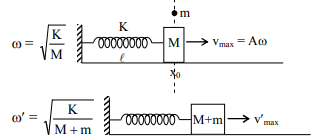Q. A block with mass $M$ is connected by a massless spring with stiffness constant $k$ to a rigid wall and moves without friction on a horizontal surface. The block oscillates with small amplitude A about an equilibrium position $x _{0}$. Consider two cases : (i) when the block is at $x _{0}$; and (ii) when the block is at $x = x _{0}+ A$. In both the cases, a particle with mass $m (< M )$ is softly placed on the block after which they stick to each other. Which of the following statement(s) is(are) true about the motion after the mass $m$ is placed on the mass $M$ ?
JEE AdvancedJEE Advanced 2016
Solution:

